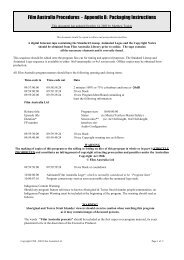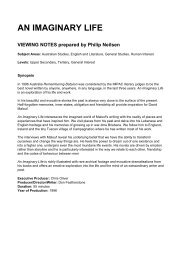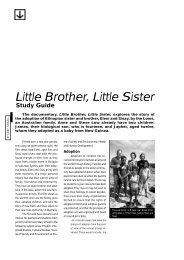Teachers Notes
Teachers Notes
Teachers Notes
Create successful ePaper yourself
Turn your PDF publications into a flip-book with our unique Google optimized e-Paper software.
1. Ben<br />
After Jack, Ben would probably be the next one<br />
that eats the most even though he’s tiny, but to<br />
me he’s catching up.<br />
– Kylie, Ben’s mum<br />
The smallest of quintuplets, Ben lives in a<br />
household of devoted carers and has overcome<br />
myriad health problems and development<br />
delays resulting from his premature birth. But<br />
as the tiniest of quintuplets with a birth weight<br />
of just 500 grams, Ben is one of the biggest<br />
eaters in his family and science suggests he<br />
could be at a high risk of becoming obese.<br />
• According to recent research, how many<br />
Australian toddlers are already overweight<br />
or obese<br />
• What is the number one predictor for a child<br />
becoming fat<br />
• What happened to Ben in his first six<br />
months of life<br />
• How did this experience affect his early<br />
development<br />
• Why might Ben now be cleaning up the<br />
bowls and leftovers of his brothers and<br />
sisters<br />
• What does the research reveal about the<br />
appetites of low birth-weight babies<br />
• What is the inevitable result of eating<br />
energy dense and nutrient poor foods and<br />
expending little energy<br />
• What are some of the reasons the parents<br />
of Ben (and some of the other children’s<br />
parents) give for finding it hard to control<br />
their own weight<br />
• How does the evidence that our bodies are<br />
designed to store fat make long-term weight<br />
loss a more difficult task<br />
• What is the second highest predictor of a<br />
child becoming overweight<br />
8

















